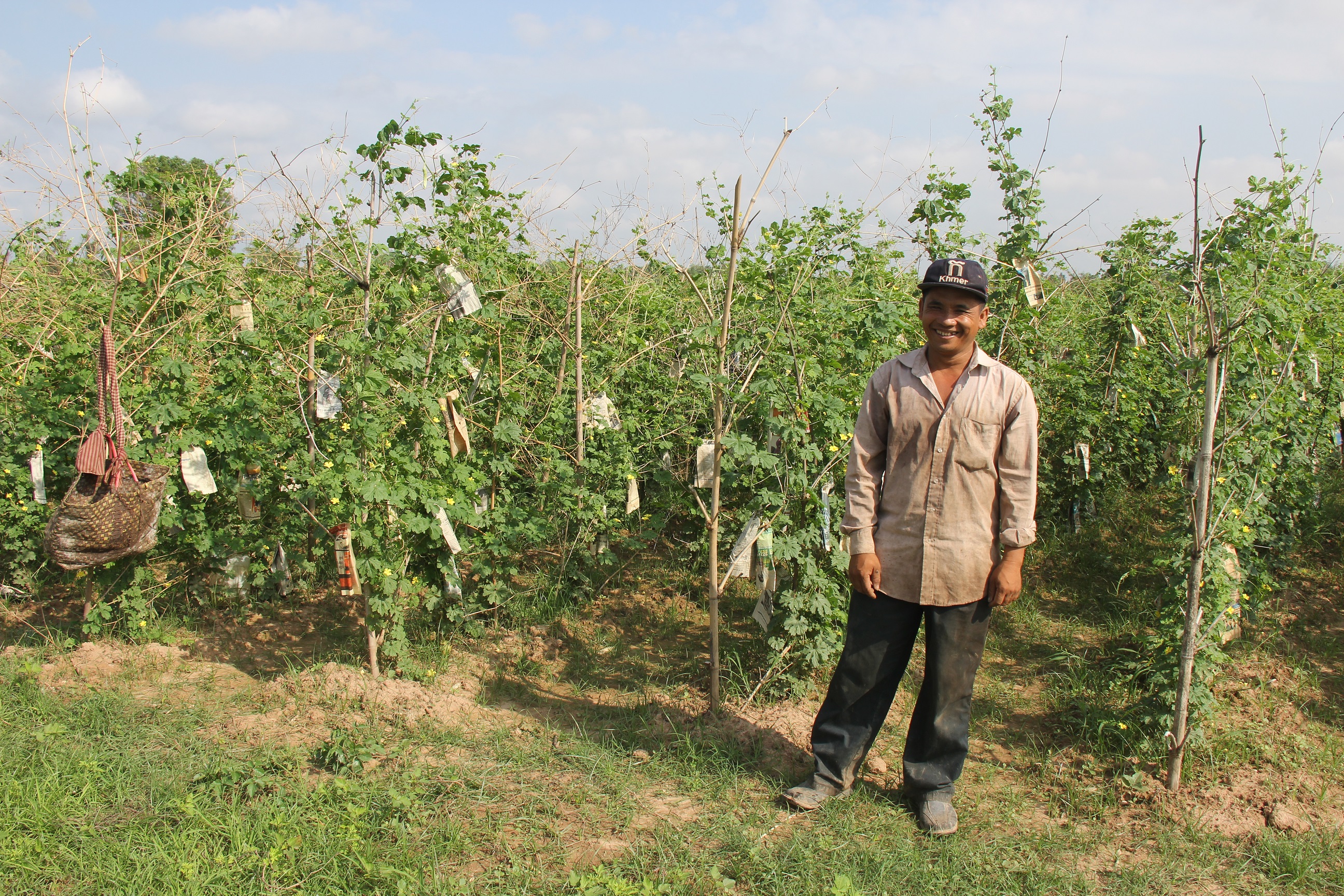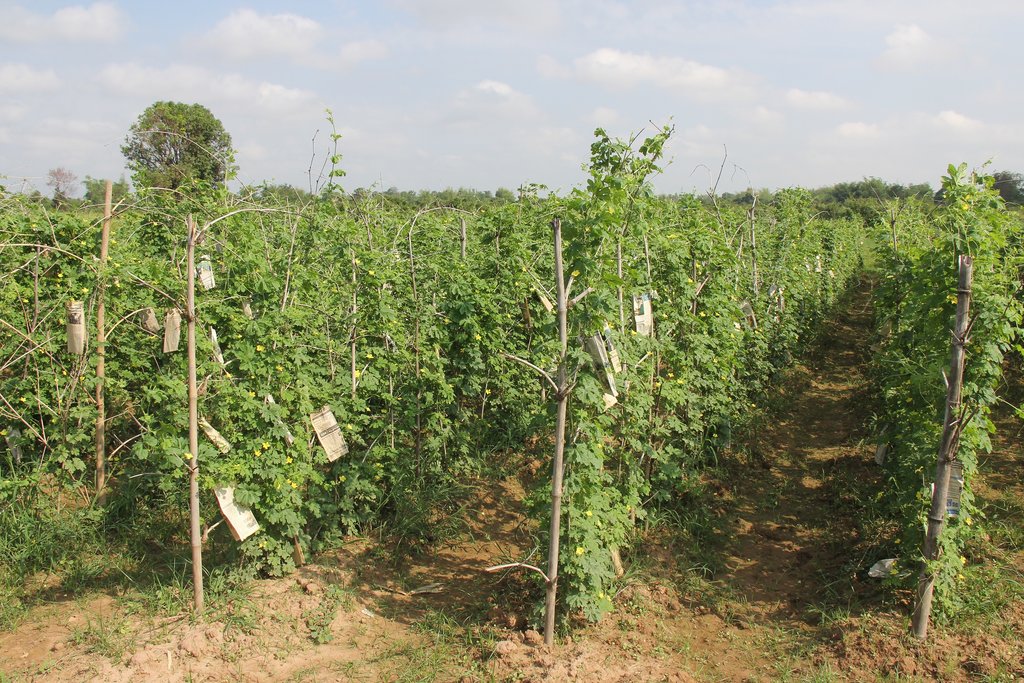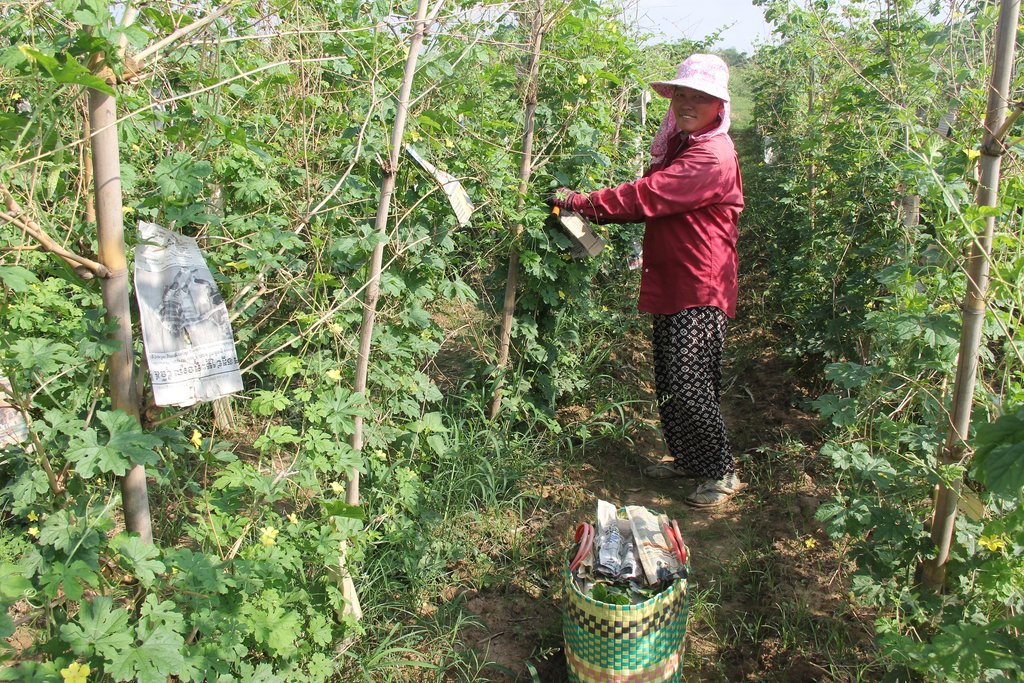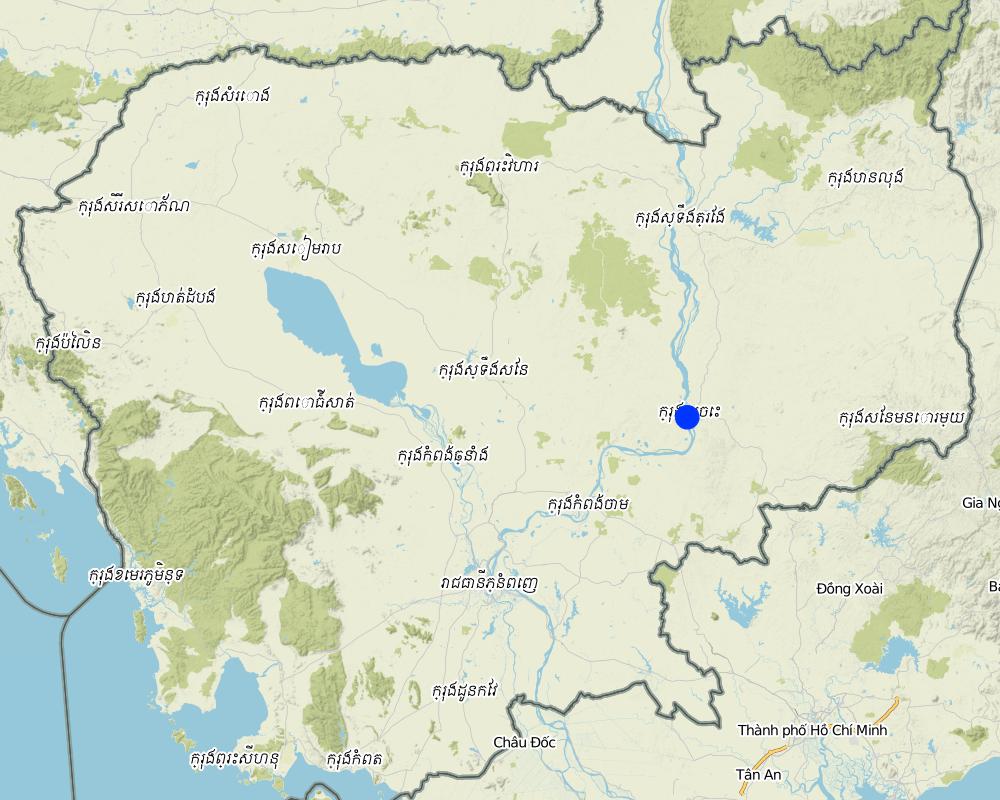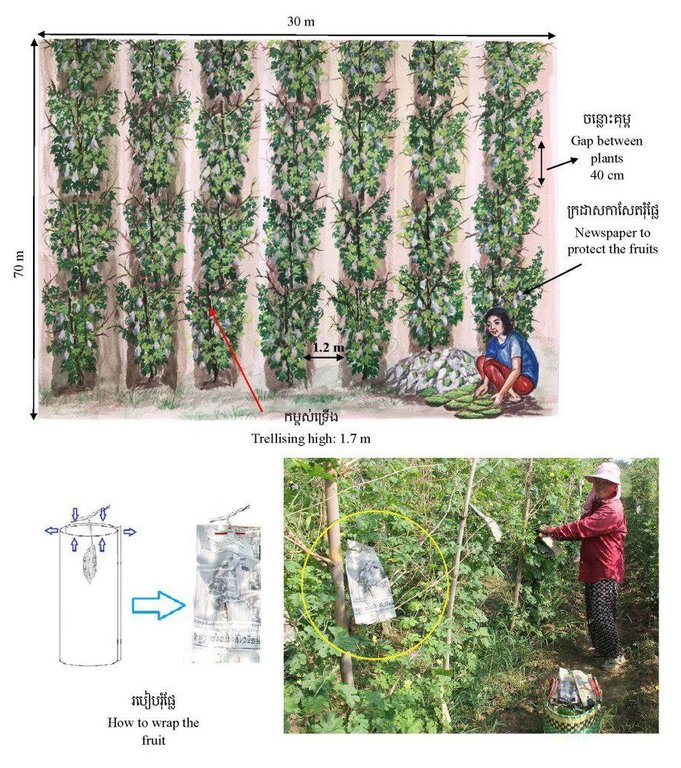Bitter gourd cultivation using recycled newspapers to protect fruits [Cambodia]
- Creation:
- Update:
- Compiler: vann vun
- Editors: Be Gechkim, Sok Pheak, Sophea Tim, Navin Chea
- Reviewers: Ursula Gaemperli, SO Than, Nicole Harari, Cornelia Hett
Bitter gourd cultivation
technologies_2101 - Cambodia
View sections
Expand all Collapse all1. General information
1.2 Contact details of resource persons and institutions involved in the assessment and documentation of the Technology
Key resource person(s)
Saob commune extension worker:
Song Sopheak
(+855) 97 942 33 88
N/A
Office of Saob commune
Saob Leu village, Saob commune, Preaek Prasab district, Kratie province
Cambodia
Deputy director of Center for Agricultural and Environmental Studies, RUA:
Tim Sophea
(+855) 12 291 592
stim3993@gmail.com / sopheatim2012@yahoo.com
Center for Agricultural and Environmental Studies, RUA
Khva village, Dangkao commune, Dangkao district, Phnom Penh
Cambodia
Agricultural office chief in Sambo district:
land user:
Houn Chanak
(+855) 90 80 824
N/A
Farmer
Preaek Roka village, Saob commune, Preaek Prasap district, Kratie province
Cambodia
Official of Chetr Borei district office of agriculture, forestry and fisheries:
Ly Saravuth
saravuthly123@gmail.com
N/A
Chetr Borei district office of agriculture, forestry and fisheries
Khsar village, Dar commune, Chetr Borei district, Kratie province
Cambodia
Name of project which facilitated the documentation/ evaluation of the Technology (if relevant)
Scaling-up SLM practices by smallholder farmers (IFAD)Name of the institution(s) which facilitated the documentation/ evaluation of the Technology (if relevant)
Royal University of Agriculture (RUA) - Cambodia1.3 Conditions regarding the use of data documented through WOCAT
When were the data compiled (in the field)?
10/04/2017
The compiler and key resource person(s) accept the conditions regarding the use of data documented through WOCAT:
Yes
1.4 Declaration on sustainability of the described Technology
Is the Technology described here problematic with regard to land degradation, so that it cannot be declared a sustainable land management technology?
No
2. Description of the SLM Technology
2.1 Short description of the Technology
Definition of the Technology:
The use of old newspapers to wrap up bitter gourd, so as to prevent the fruit from being damaged by insects, and to protect them from direct sunlight and contact with pesticides. This agricultural approach only uses animal manure, fish heads and urea (46-0-0) as fertilizer to improve the soil’s quality.
2.2 Detailed description of the Technology
Description:
Bitter gourd is a crop that can be supported by trellises and it is possible to plant it throughout the year. However it is not recommended to grow it in areas with strong winds because then it takes longer to grow. Bitter gourd requires more fertile soil than other varieties in the Cucurbitaceae family. It needs to be well-saturated or loamy soil with a pH of 6 to 6.8. The most suitable land can be found along river banks, streams, and lakes with high silt content. Bitter gourds are susceptible to be damaged by pests and diseases. In order to protect the fruit from pests, plastic, paper or other materials are wrapped around the fruit. Additionally, the crop needs nets for climbing, which can be quite expensive (Agritoday, 2016).
In this case study the farmer plants bitter gourds by using bamboo sticks to construct the trellis for plant climbing. And he wraps up the fruits with old newspapers. This growing technique is less expensive than using nets for plant climbing and medium A4 sized brown paper envelopes to protect the fruit. The bamboo sticks can be used for two years, and during this period the farmer is able to make use of them three to four times a year. The newspapers that have been bought to protect the fruit can be used two or three times, so as not only to reduce the cost but also to reduce the environmental impact. Covering the fruit with newspapers is better than using plastic bags or pages from books, because plastic bags can easily become too hot, and pages are particularly vulnerable to rain or water. The main purpose of wrapping up the bitter gourd with newspapers is to protect them from insects, especially the fruit fly. However it also protects them from the heat of the sun makes the fruit whiter, and acts as a protection against pesticides as this would otherwise be directly sprayed onto the fruit. Insecticides normally last an average of 7 to 10 days and plants will then have to be sprayed again to prevent the return of the insects. Farmers are able to harvest the bitter gourd about 15 days after pinned with newspaper.
As the area is flooded by the Mekong River during the months of August - October, it is not possible to plant bitter gourd in the rainy season. After the water has receded the soil should be ploughed and dried by the sun for 15 days. After this the soil should be plowed again, and then the field needs to be harrowed evenly and the soil left to dry for three more days. Fertilizers should not be added whilst ploughing. Planting is done by firstly using a hoe to scratch a central trench in the field. Further parallel lines to this trench should be 1.2 meters apart and the bitter gourd seeds should then be planted along the lines, at 40 centimeter intervals. Once the seeds are in the ground manure, cow or buffalo compost should be applied over the top and then watered. Before growing, it should be soaked for 2 hours and then covered with cloth. Afterwards they should be left to soak in a steady flow of water for 4 to 5 days until the shoots begin to grow. After when the developing bitter melon is 15 days old a bamboo pole with bamboo sticks of about 1.7 meters height and 10 cm from the plants has to be placed. A further 15 days after having put up the poles, the soil should be loosen up again and then the fish head fertilizer mixed with a little bit of UREA is applied. The fertilizer should be spread about 30 to 40 cm from plants, or it can be added between the bitter gourd clumps, which can also be combined with manure and UREA. Watering should be done twice a day, once in the morning and once in the evening. The irrigation system involves pumping water from a nearby lake. Even though pesticides are used regularly, if paper is not used to protect the fruits, they can still be affected by pests. Once affected the fruit falls down, becomes stunted, grows into irregular shapes, the color becomes dull. In case the fruit were directly affected by the poison it could be harmful to people’s health. Any combination of these physical symptoms can be identified very easily and monitored by the farmers themselves. Since the use of this technique the farmer’s income has increased because they are able to grow a product of good quality and high output.
2.3 Photos of the Technology
2.4 Videos of the Technology
Comments, short description:
N/A
Name of videographer:
N/A
2.5 Country/ region/ locations where the Technology has been applied and which are covered by this assessment
Country:
Cambodia
Region/ State/ Province:
Preaek Roka village, Saob commune, Preaek Prasap district, Kratie province
Further specification of location:
Floodplain which is flooded from August until September
Map
×2.6 Date of implementation
If precise year is not known, indicate approximate date:
- 10-50 years ago
2.7 Introduction of the Technology
Specify how the Technology was introduced:
- as part of a traditional system (> 50 years)
Comments (type of project, etc.):
Doing as traditional ways by using tree's branches as the trellising and changed to bamboo branches, which is similar.
3. Classification of the SLM Technology
3.1 Main purpose(s) of the Technology
- improve production
- Protecting fruit from insects
3.2 Current land use type(s) where the Technology is applied

Cropland
- Annual cropping
Main crops (cash and food crops):
Bitter melon which can harvested during around 1,5 month.
Comments:
Plantation of bitter gurd can be done by the farmer from November to July because from August to October the plain will be flooded an no planting is possible.
If land use has changed due to the implementation of the Technology, indicate land use before implementation of the Technology:
Before this land was planted by corn, cucumber, and sesame.
3.3 Further information about land use
Water supply for the land on which the Technology is applied:
- mixed rainfed-irrigated
Comments:
Lake is about 500 m in distance (last year lake dried up because of the drought).
Number of growing seasons per year:
- 2
Specify:
First, planted in early December and then in late February for the second time.
3.4 SLM group to which the Technology belongs
- integrated soil fertility management
- integrated pest and disease management (incl. organic agriculture)
3.5 Spread of the Technology
Specify the spread of the Technology:
- evenly spread over an area
If the Technology is evenly spread over an area, indicate approximate area covered:
- < 0.1 km2 (10 ha)
Comments:
He planted bitter melon on about 2100 square meters which is the rented land. At the time he has to pay 100000 Riel for this land.
3.6 SLM measures comprising the Technology

agronomic measures
- A1: Vegetation/ soil cover
- A2: Organic matter/ soil fertility

other measures
Comments:
Wrapping up the green gourd fruit with newspaper
3.7 Main types of land degradation addressed by the Technology

chemical soil deterioration
- Cn: fertility decline and reduced organic matter content (not caused by erosion)

biological degradation
- Bc: reduction of vegetation cover
- Bl: loss of soil life
3.8 Prevention, reduction, or restoration of land degradation
Specify the goal of the Technology with regard to land degradation:
- prevent land degradation
Comments:
Before the farmer has leased the land and this land was covered by the fabaceae plant Mimosa Pigra which is known as nitrogen fixing plant. When the farmer leased the land he burned down the mimosa plant and got a very fertile soil (not much fertilizer had to be applied).
4. Technical specifications, implementation activities, inputs, and costs
4.1 Technical drawing of the Technology
4.2 Technical specifications/ explanations of technical drawing
The size of the plot of land is 2100 square meters (a width of 30 meters x a length of 70 meters) containing 25 rows, which are about 70 meters in length and 1.2 meters apart from each other. Along each row there is a distance of 40 cm between each plant and the trellises have a height of 1.70 meters. Then the fruit have been wrapped with newspaper to protected from sunlight, insects and pesticide applied, and also to keep the fruit white.
4.3 General information regarding the calculation of inputs and costs
Specify how costs and inputs were calculated:
- per Technology area
Indicate size and area unit:
2100 square meters
other/ national currency (specify):
Riel
Indicate exchange rate from USD to local currency (if relevant): 1 USD =:
4000.0
Indicate average wage cost of hired labour per day:
20000 Riel
4.4 Establishment activities
| Activity | Type of measure | Timing | |
|---|---|---|---|
| 1. | First plow is keeping 15 days | Agronomic | December |
| 2. | Second plow is keeping 3 days | Agronomic | December |
| 3. | Nursery and propagation | Agronomic | December |
| 4. | Draw the line and planting | Agronomic | January |
| 5. | Watering | Agronomic | January |
| 6. | Collection of bamboo branches | Management | November |
| 7. | Prepare fish head fertilizer, compost, and urea (46-0-0) | Management | August or September |
| 8. | Prepare newspaper for wrap up fruits | Management | December |
| 9. | Buying the tools such as spade, knife, large basket, and water pumping machine. | Management | November |
| 10. | Self keeping seeds | Management | March |
Comments:
Most labor is provided by themselves and he keeps his own seeds after harvesting.
4.5 Costs and inputs needed for establishment
| Specify input | Unit | Quantity | Costs per Unit | Total costs per input | % of costs borne by land users | |
|---|---|---|---|---|---|---|
| Labour | Nursery and watering | peson-day | 3.5 | 20000.0 | 70000.0 | 100.0 |
| Labour | Plowing 2 times | peson-day | 3.75 | 20000.0 | 75000.0 | 100.0 |
| Labour | Draw the line and planting | peson-day | 8.0 | 20000.0 | 160000.0 | 100.0 |
| Equipment | Pumping machine | piece | 1.0 | 1600000.0 | 1600000.0 | 100.0 |
| Equipment | Spade | piece | 2.0 | 20000.0 | 40000.0 | 100.0 |
| Equipment | Knife | piece | 2.0 | 20000.0 | 40000.0 | 100.0 |
| Equipment | Large basket | pair | 1.0 | 5000.0 | 5000.0 | 100.0 |
| Plant material | Seeds | seed | 3000.0 | 60.0 | 180000.0 | 100.0 |
| Fertilizers and biocides | Fish head fertilizer, compost and urea | kg | 200.0 | 2500.0 | 500000.0 | 100.0 |
| Construction material | Bamboo branches | piece | 100.0 | 5000.0 | 500000.0 | 100.0 |
| Other | Newspaper | kg | 40.0 | 1000.0 | 40000.0 | 100.0 |
| Other | Spraying tank | piece | 1.0 | 80000.0 | 80000.0 | 100.0 |
| Total costs for establishment of the Technology | 3290000.0 | |||||
4.6 Maintenance/ recurrent activities
| Activity | Type of measure | Timing/ frequency | |
|---|---|---|---|
| 1. | Making soil soft and adding fertilizer | Agronomic | after the plants are 15 days old |
| 2. | Adding more soil at bottom of plants, putting fertilizer and trellising | Structural | After making the soil soft during 15 days |
| 3. | Watering | Agronomic | Everyday (morning and evening) |
| 4. | Checking for insects | Management | Everyday |
| 5. | Wrap up fruits with newspaper | Management | When fruits are provided |
| 6. | Spraying pesticide to prevent insects | Management | When insects are appeared |
| 7. | Spraying fish head fertilizer, animals manure, and urea | Management | 3 times for life cycle |
Comments:
One life cycle of bitter gourd is 3 months.
4.7 Costs and inputs needed for maintenance/ recurrent activities (per year)
| Specify input | Unit | Quantity | Costs per Unit | Total costs per input | % of costs borne by land users | |
|---|---|---|---|---|---|---|
| Labour | Making the soil to be soft, adding more soil at bottom of plants, and trellising | person-day | 8.0 | 20000.0 | 160000.0 | 100.0 |
| Fertilizers and biocides | Urea (46-0-0)) | kg | 6.0 | 2500.0 | 15000.0 | 100.0 |
| Fertilizers and biocides | Pesticide | bottle | 2.0 | 15000.0 | 30000.0 | 100.0 |
| Fertilizers and biocides | Fish head | kg | 50.0 | 600.0 | 30000.0 | 100.0 |
| Other | Gasoline to pumping for irrigation (3 months) | liter | 45.0 | 3200.0 | 144000.0 | 100.0 |
| Total costs for maintenance of the Technology | 379000.0 | |||||
4.8 Most important factors affecting the costs
Describe the most determinate factors affecting the costs:
High costs for pumping machine, fish head fertilizer and compost.
5. Natural and human environment
5.1 Climate
Annual rainfall
- < 250 mm
- 251-500 mm
- 501-750 mm
- 751-1,000 mm
- 1,001-1,500 mm
- 1,501-2,000 mm
- 2,001-3,000 mm
- 3,001-4,000 mm
- > 4,000 mm
Specify average annual rainfall (if known), in mm:
1138.20
Specifications/ comments on rainfall:
The average annual rainfall in 2015 is 1138.2 mm, in 2014 is 1696.5 mm in 2013 is 1661.8 mm.
Indicate the name of the reference meteorological station considered:
Ministry of Water Resources and Meteorology (2015)
Agro-climatic zone
- sub-humid
The weather is hot and humid that contain two seasons, dry and rainy season, and last year the weather was warmer than every year.
5.2 Topography
Slopes on average:
- flat (0-2%)
- gentle (3-5%)
- moderate (6-10%)
- rolling (11-15%)
- hilly (16-30%)
- steep (31-60%)
- very steep (>60%)
Landforms:
- plateau/plains
- ridges
- mountain slopes
- hill slopes
- footslopes
- valley floors
Altitudinal zone:
- 0-100 m a.s.l.
- 101-500 m a.s.l.
- 501-1,000 m a.s.l.
- 1,001-1,500 m a.s.l.
- 1,501-2,000 m a.s.l.
- 2,001-2,500 m a.s.l.
- 2,501-3,000 m a.s.l.
- 3,001-4,000 m a.s.l.
- > 4,000 m a.s.l.
Indicate if the Technology is specifically applied in:
- concave situations
Comments and further specifications on topography:
The land is in the floodplain area, which is flooded from September until November.
5.3 Soils
Soil depth on average:
- very shallow (0-20 cm)
- shallow (21-50 cm)
- moderately deep (51-80 cm)
- deep (81-120 cm)
- very deep (> 120 cm)
Soil texture (topsoil):
- medium (loamy, silty)
Soil texture (> 20 cm below surface):
- medium (loamy, silty)
Topsoil organic matter:
- medium (1-3%)
If available, attach full soil description or specify the available information, e.g. soil type, soil PH/ acidity, Cation Exchange Capacity, nitrogen, salinity etc.
The pH of this soil is 5 and depth of soil is 20 m with the kind of loam soil in the top soil.
5.4 Water availability and quality
Ground water table:
> 50 m
Availability of surface water:
good
Water quality (untreated):
for agricultural use only (irrigation)
Is water salinity a problem?
No
Is flooding of the area occurring?
Yes
Regularity:
frequently
Comments and further specifications on water quality and quantity:
When the lake is dried up he used water from river instead. Generally this area is flooded every year.
5.5 Biodiversity
Species diversity:
- low
Habitat diversity:
- low
5.6 Characteristics of land users applying the Technology
Sedentary or nomadic:
- Sedentary
other (specify):
During flood he cultivates at other places.
Market orientation of production system:
- mixed (subsistence/ commercial
Off-farm income:
- less than 10% of all income
Relative level of wealth:
- average
Individuals or groups:
- individual/ household
Level of mechanization:
- manual work
- mechanized/ motorized
Gender:
- men
Age of land users:
- middle-aged
Indicate other relevant characteristics of the land users:
Almost the whole income of family is coming from agriculture.The farmer started doing this since he was single. Now he is 40 years old.
5.7 Average area of land owned or leased by land users applying the Technology
- < 0.5 ha
- 0.5-1 ha
- 1-2 ha
- 2-5 ha
- 5-15 ha
- 15-50 ha
- 50-100 ha
- 100-500 ha
- 500-1,000 ha
- 1,000-10,000 ha
- > 10,000 ha
Is this considered small-, medium- or large-scale (referring to local context)?
- medium-scale
Comments:
He had 3.6 ha for cashew cultivation, 0.5 ha as rice fields, other land for vegetable plantation is 0.3 ha, and he leased 0.21 ha for bitter melon plantation.
5.8 Land ownership, land use rights, and water use rights
Land ownership:
- individual, titled
- Hire
Land use rights:
- leased
- individual
- Hire
Water use rights:
- open access (unorganized)
Comments:
Before he got an own pumping machine but when the pond dried out he hired another pumping machine.
5.9 Access to services and infrastructure
health:
- poor
- moderate
- good
education:
- poor
- moderate
- good
technical assistance:
- poor
- moderate
- good
employment (e.g. off-farm):
- poor
- moderate
- good
markets:
- poor
- moderate
- good
energy:
- poor
- moderate
- good
roads and transport:
- poor
- moderate
- good
drinking water and sanitation:
- poor
- moderate
- good
financial services:
- poor
- moderate
- good
6. Impacts and concluding statements
6.1 On-site impacts the Technology has shown
Socio-economic impacts
Production
crop quality
Comments/ specify:
Using newspaper to wrap up is making the bitter melon healthier.
Income and costs
expenses on agricultural inputs
Comments/ specify:
The expenses on agricultural inputs are reduced due to less use of chemical fertilizer (little use of mixture of urea, animals manure and fish head fertilizer) and less expenses as instead of expensive nets he uses bamboo sticks and also he uses cheaper newspaper for fruit protection.
farm income
Comments/ specify:
The income is increased due to reduction of insects damaging.
workload
Comments/ specify:
It is increased a bit because he has to wrap up all fruits.
Ecological impacts
Biodiversity: vegetation, animals
pest/ disease control
Comments/ specify:
This newspaper wrap up technique controls only pest.
6.2 Off-site impacts the Technology has shown
impact of greenhouse gases
Comments/ specify:
Reused of newspaper and bamboo branches for optimizing.
Comments regarding impact assessment:
Some farmers followed him by using bamboo branches and newspapers as well.
6.3 Exposure and sensitivity of the Technology to gradual climate change and climate-related extremes/ disasters (as perceived by land users)
Gradual climate change
Gradual climate change
| Season | Type of climatic change/ extreme | How does the Technology cope with it? | |
|---|---|---|---|
| annual temperature | increase | moderately | |
| seasonal rainfall | wet/ rainy season | increase | moderately |
Comments:
This area is rain every year in April that cause from fired forest field or finding wildlife. About insects on the bitter melon are worm, wasp.
6.4 Cost-benefit analysis
How do the benefits compare with the establishment costs (from land users’ perspective)?
Short-term returns:
positive
Long-term returns:
positive
How do the benefits compare with the maintenance/ recurrent costs (from land users' perspective)?
Short-term returns:
positive
Long-term returns:
positive
Comments:
Looking for job sees to be less profitable than growing vegetables. Bitter melon can be harvested during half a month and could be cultivated twice a year.
6.5 Adoption of the Technology
- 1-10%
If available, quantify (no. of households and/ or area covered):
There are about 6 families in the village who practice this technique as well.
Of all those who have adopted the Technology, how many have did so spontaneously, i.e. without receiving any material incentives/ payments?
- 90-100%
6.6 Adaptation
Has the Technology been modified recently to adapt to changing conditions?
No
6.7 Strengths/ advantages/ opportunities of the Technology
| Strengths/ advantages/ opportunities in the land user’s view |
|---|
| Gain of a variety of benefits because they do not have to hire labor or buy bamboo sticks and they have animal manure. |
| Reduced use of chemical fertilizers as instead they are using fish head fertilizer. |
| Strengths/ advantages/ opportunities in the compiler’s or other key resource person’s view |
|---|
| Bamboo sticks do not cause additional costs because they can be gathered for free. |
| Using newspapers does not cause negative environmental impacts compared to the the use of plastic and it also reduces the need for pesticides. |
| Fish head fertilizer and animal manure helps to improve the soil’s fertility and reduces the need for chemical fertilizer. |
| Reduced cost of planting materials. |
6.8 Weaknesses/ disadvantages/ risks of the Technology and ways of overcoming them
| Weaknesses/ disadvantages/ risks in the land user’s view | How can they be overcome? |
|---|---|
| Pesticide was applied without protection of the fruit but it did not work. | Wrap up bitter gourd in newspaper before applying pesticide and then check the fruit regularly. |
| No water in the pond during the dry season. | Use water from the river by pumping instead. |
| Expense of buying pipes to pump water from a distant source. | Borrow from others and take a loan from retailers. |
| Low market price of the bitter gourd. | There is no solution for market yet. |
7. References and links
7.1 Methods/ sources of information
- field visits, field surveys
A place
- interviews with land users
A person
- interviews with SLM specialists/ experts
4 people
7.3 Links to relevant information which is available online
Title/ description:
Agritoday (2016). Bitter Gourd. Retrieved December 06, 2017
URL:
http://agritoday.com/view/2084.html
Links and modules
Expand all Collapse allLinks
No links
Modules
No modules


